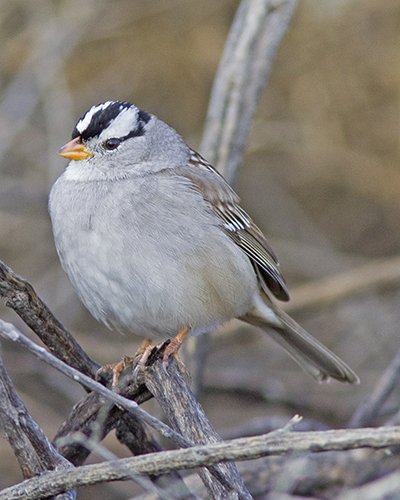Birds of the Whitewater Preserve: White-Crowned Sparrow
Field notes from ornithologist, Stephen Myers
White-crowned Sparrow
A couple of weeks ago, “Gambel’s” White-crowned Sparrows (Zonotrichia leucophrys gambelii) started arriving at the Whitewater Preserve. This subspecies is among the most numerous of birds spending the winter in southern California, and can be found in a wide variety of shrubby habitats. The fact that they usually occur in flocks, and are often more or less in the open, make them a frequently sighted species during winter Birding.
During the breeding season the Gambel’s race of White-crowned Sparrow occurs from northwestern Alaska east across Canada to Hudson Bay. Habitats in their nesting range include boreal forest, tundra, and alpine meadows. Nests are in grasses, bare ground, or low in shrubs. The female builds the nest, which is comprised of small sticks, grass stems, pine needles, moss, dead leaves, and shreds of bark. Only the female incubates, and the eggs hatch in about 12 days. The nestlings fledge about 10 days after hatching.
The diets of White-crowned Sparrows are mainly plant matter, mostly seeds. During nesting, arthropods are also eaten, including butterflies and moths, beetles, and true bugs. On wintering grounds, diets are almost exclusively seeds.
Identifying adult White-crowned Sparrows is straight-forward. They are a medium-sized sparrow with light gray underparts, a whitish throat, black-and-white striped heads, and grayish backs streaked with brown. Immatures are a bit trickier. Their plumages are similar to adults, except that instead of black-and-white striped heads, theirs are tan and brown striped. In both ages males and females are identically plumaged.
As stated above, the subspecies that dominates wintering populations in southern California is gambelii. Occasionally, a different subspecies is also seen in our area, mainly during migration periods. That subspecies, Z. l. oriantha, also called the “Mountain” White-crowned Sparrow, breeds at high elevations throughout the intermountain west, including the Sierra Nevadas and on Mt. San Gorgonio. The Mountain subspecies can be distinguished from the Gambel’s subspecies by the fact that the area between the eye and the base of the bill (called the lores) is black. The lores are white in the Gambel’s race.
When White-crowned Sparrows begin arriving in mid September, they can often be heard singing their distinctive songs, which are one or two long notes followed by a jumble of sweet notes. They sing fairly often during winter, and increase the frequency as they prepare to migrate back north in April. It is a bit sad when one realizes their singing is over for the season, and one will have to wait until next September to enjoy them again!
Speaking of migration, colleagues and I banded a Gambel’s White-crown in Riverside a couple of January's past, and it was recovered in northern British Columbia the following April, having migrated over 1,400 miles! The feeding station at the Preserve is a great place to sit and watch the White-crowns. Once in a while there are upwards of 50 or so coming into the feeders at once, and it is a good time for birders to sort through them, and learn to tell the adults from immatures.
Steve Myers is an ornithologist and retired wildlife biologist and photographer who resides in Riverside County. He is an active volunteer for The Wildlands Conservancy and leads frequent bird walks at Whitewater Preserve.

